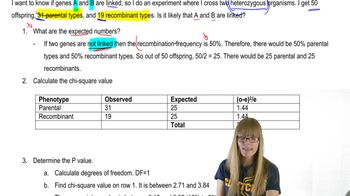Using the appropriate chi-square value and degrees of freedom, do the coat color and hair length genes assort independently?
Table of contents
- 1. Introduction to Genetics51m
- 2. Mendel's Laws of Inheritance3h 37m
- 3. Extensions to Mendelian Inheritance2h 41m
- 4. Genetic Mapping and Linkage2h 28m
- 5. Genetics of Bacteria and Viruses1h 21m
- 6. Chromosomal Variation1h 48m
- 7. DNA and Chromosome Structure56m
- 8. DNA Replication1h 10m
- 9. Mitosis and Meiosis1h 34m
- 10. Transcription1h 0m
- 11. Translation58m
- 12. Gene Regulation in Prokaryotes1h 19m
- 13. Gene Regulation in Eukaryotes44m
- 14. Genetic Control of Development44m
- 15. Genomes and Genomics1h 50m
- 16. Transposable Elements47m
- 17. Mutation, Repair, and Recombination1h 6m
- 18. Molecular Genetic Tools19m
- 19. Cancer Genetics29m
- 20. Quantitative Genetics1h 26m
- 21. Population Genetics50m
- 22. Evolutionary Genetics29m
4. Genetic Mapping and Linkage
Chi Square and Linkage
Problem 15d
Textbook Question
Three dominant traits of corn seedlings, tunicate seed (T-), glossy appearance (G-), and liguled stem (L-), are studied along with their recessive counterparts, nontunicate (tt), nonglossy (gg), and liguleless (ll). A trihybrid plant with the three dominant traits is crossed to a nontunicate, nonglossy, liguleless plant. Kernels on ears of progeny plants are scored for the traits, with the following results:

If evidence of linkage is present, calculate the recombination frequency or frequencies from the data presented.
 Verified step by step guidance
Verified step by step guidance1
Step 1: Understand the problem. This is a trihybrid cross involving three traits: tunicate seed (T), glossy appearance (G), and liguled stem (L), each with dominant and recessive alleles. The trihybrid plant (TtGgLl) is crossed with a homozygous recessive plant (ttggll). The goal is to determine if there is evidence of linkage between any of the genes and, if so, calculate the recombination frequency.
Step 2: Identify parental and recombinant phenotypes. Parental phenotypes are those that match the original combinations of alleles in the parents (T-G-L- and ttggll). Recombinant phenotypes are those that result from crossing over, leading to new combinations of alleles. From the data, identify which phenotypes are parental and which are recombinant.
Step 3: Calculate the total number of parental and recombinant offspring. Add the counts of the parental phenotypes together and the counts of the recombinant phenotypes together. This will help determine the proportion of recombinants in the total population.
Step 4: Calculate the recombination frequency. The recombination frequency is calculated as the number of recombinant offspring divided by the total number of offspring, multiplied by 100 to express it as a percentage. Use the formula: .
Step 5: Interpret the recombination frequency. If the recombination frequency is less than 50%, it suggests that the genes are linked and located on the same chromosome. If it is close to 50%, the genes are likely unlinked and assort independently. Use the calculated recombination frequency to determine the degree of linkage between the genes.
 Verified video answer for a similar problem:
Verified video answer for a similar problem:This video solution was recommended by our tutors as helpful for the problem above
Video duration:
2mPlay a video:
Was this helpful?
Key Concepts
Here are the essential concepts you must grasp in order to answer the question correctly.
Mendelian Genetics
Mendelian genetics is the study of how traits are inherited through generations based on the principles established by Gregor Mendel. It involves understanding dominant and recessive alleles, where dominant traits mask the expression of recessive ones. This framework is essential for analyzing inheritance patterns in the corn seedlings, as it helps predict the phenotypic ratios expected from specific crosses.
Recommended video:
Guided course

Descriptive Genetics
Linkage and Recombination
Linkage refers to the tendency of genes located close to each other on a chromosome to be inherited together. Recombination occurs during meiosis when homologous chromosomes exchange genetic material, leading to new allele combinations. The recombination frequency quantifies this exchange, providing insight into the genetic distance between linked genes, which is crucial for interpreting the results of the corn seedling cross.
Recommended video:
Guided course

Chi Square and Linkage
Phenotypic Ratios
Phenotypic ratios represent the relative frequencies of different phenotypes in the offspring resulting from a genetic cross. In this case, the observed phenotypes of the progeny plants can be analyzed to determine if they align with expected Mendelian ratios or indicate linkage. Understanding these ratios is vital for calculating recombination frequencies and assessing the genetic relationships among the traits studied.
Recommended video:
Guided course

Mutations and Phenotypes

 7:33m
7:33mWatch next
Master Chi Square and Linkage with a bite sized video explanation from Kylia
Start learningRelated Videos
Related Practice
Multiple Choice
767
views
3
rank
